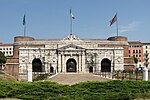Battle of Verona (1805)

The Battle of Verona was fought on 18 October 1805 between the French Army of Italy under the command of André Masséna and an Austrian army led by Archduke Charles, Duke of Teschen. By the end of the day, Massena seized a bridgehead on the east bank of the Adige River, driving back the defending troops under Josef Philipp Vukassovich. The action took place near the city of Verona in northern Italy during the War of the Third Coalition, part of the Napoleonic Wars. In the fall of 1805, Emperor Napoleon I of France planned for his powerful Grande Armée to fall upon and crush the Austrian Empire army in southern Germany. The French emperor hoped to win the war in the Danube valley. To help accomplish this purpose, Napoleon wanted Masséna to hold Archduke Charles' large army in Italy for as long as possible. In order for Masséna to grapple with his enemies, it was necessary to establish a bridgehead on the east bank of the Adige. During the battle, the French attacked across the river, cleared two suburbs, and seized some high ground on the opposite bank. The Austrians suffered considerably more casualties than the French in the encounter. This clash set the stage for the subsequent Battle of Caldiero on 29 to 31 October.
Excerpt from the Wikipedia article Battle of Verona (1805) (License: CC BY-SA 3.0, Authors, Images).Battle of Verona (1805)
Circonvallazione Alfredo Oriani, Verona San Zeno
Geographical coordinates (GPS) Address Nearby Places Show on map
Geographical coordinates (GPS)
| Latitude | Longitude |
|---|---|
| N 45.4333 ° | E 10.9833 ° |
Address
Circonvallazione Alfredo Oriani
Circonvallazione Alfredo Oriani
37123 Verona, San Zeno
Veneto, Italy
Open on Google Maps










